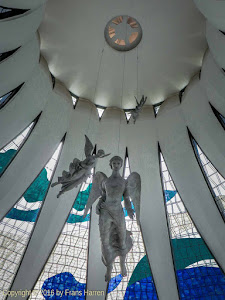Alfredo Ceschiatti
Alfredo Ceschiatti (Belo Horizonte MG 1918 - Rio de Janeiro 1989). Sculptor, designer, teacher. In 1938, he traveled to Italy and is interested, above all, works by Renaissance artists. In 1940, in Rio de Janeiro, he entered the National School of Fine Arts - Enba, where he studied sculpture with Corrêa Lima (1878-1974). Attended the studio installed in the National Library, Rio de Janeiro, along with Bruno Giorgi (1905 - 1993) and José Pedrosa (1915-2002). Creates, in 1944, the bas-relief of the Church of St. Francis of Assisi in Pampulha in Belo Horizonte, ordered by Oscar Niemeyer (1907-2012). The following year he wins with this work the prize trip abroad at the 51st National Salon of Fine Arts in Rio de Janeiro. Between 1946 and 1948 remains in Europe. His first solo exhibition takes place at the headquarters of the Institute of Architects of Brazil - IAB, in Rio de Janeiro in 1948. In 1956 he is part of the winning team of the design competition for the Monument to the Dead of World War II, in Rio de Janeiro. In the early 1960s, he teaches sculpture and drawing at the University of Brasilia - UNB. Several of his works are in public spaces and buildings, including the Palácio da Alvorada, the Praça dos Três Poderes and the Palácio dos Arcos in Brasilia; the Memorial da América Latina and the Praça da Sé in São Paulo; and the Embassy of Brazil in Moscow.
The Alfredo Ceschiatti sculptures are present in important public spaces of Brasilia as the Duas Irmãs (1966), in the Palácio dos Arcos; and the Angels (1970) and the Evangelists (1968) in the Cathedral of Brasilia. The sculptor explores quite the female figure, represented in his works with curvilinear forms, pure, rounded, they have, as a counterpoint, the movement of the draperies.
Ceschiatti develops his sculptures through a sensitive route, as pointed out by the art critic Sheila Leimer, providing balance and lightness to works like the Angels in the Cathedral of Brasilia, or Contorcionista (1952). The artist, who is very interested by the baroque, rescues some elements of this tradition in several of his works, combining them to more formal simplification.
See: Enciclopédia Itaú Cultural de Arte e Cultura Brasileiras
Cathedral of Brasília
The Catedral Metropolitana Nossa Senhora Aparecida (Metropolitan Cathedral of Our Lady of Aparecida) is the Roman Catholic cathedral serving Brasília, Brazil, and serves as the seat of the Archdiocese of Brasília. It was designed by Oscar Niemeyer, and was completed and dedicated on May 31, 1970. The cathedral is a hyperboloid structure constructed from 16 concrete columns, weighing 90 tons each.
A 20-meter tall bell tower containing four large bells, donated by Spanish residents of Brazil and cast in Miranda de Ebro, stands outside the cathedral.
Visitors enter into the cathedral through a dark tunnel and emerge into a bright space with a glass roof. The outer roof of the cathedral is composed of sixteen pieces of fiberglass, each 10 meters wide at the base and 30 meters long inserted between the concrete pillars. Under this is suspended a 2,000-square-meter stained glass work originally created in 1990 by Marianne Peretti, in shades of blue, green, white, and brown.
Inside the cathedral over the nave are sculptures of three angels, suspended by steel cables. The shortest is 2.22 meters long and weighs 100 kilograms, the middle one 3.4 meters long and weighs 200 kilograms, and the largest is 4.25 meters long and weighs 300 kilograms. The sculptures are by Alfredo Ceschiatti, with the collaboration of Dante Croce in 1970.
The altar was donated by Pope Paul VI. The image of the patron saint Our Lady of Aparecida is a replica of the original which is in Aparecida - São Paulo. The Way of the Cross is a work of Di Cavalcanti.
The Cathedral of Brasilia, officially the Metropolitan Cathedral of Our Lady of Aparecida (Catedral Metropolitana Nossa Senhora Aparecida), dedicated to the Blessed Virgin Mary under her title of Our Lady of Aparecida, proclaimed by the Church as Queen and Patroness of Brazil, was designed by the architect Oscar Niemeyer.
This concrete-framed hyperboloid structure, appears with its glass roof to be reaching up, open, to heaven. Most of the cathedral is below ground, with only the 70-meter diameter 42-meter roof of the cathedral, the ovoid roof of the baptistry, and the bell tower visible above ground. The shape of the roof is based in a hyperboloid of revolution with asymmetric sections. The hyperboloid structure consists of 16 identical concrete columns assembled on site. These columns, having hyperbolic section and weighing 90 tonnes, represent two hands moving upwards to heaven.
The cornerstone was laid on September 12, 1958, and the structure was finished on April 21, 1960, with only the roof structure visible above ground. The cathedral was consecrated on October 12, 1968 (still with no roof), and was officially opened by Cardinal D. Eugenio Salles on May 31, 1970. The ovoid baptistry was dedicated on October 5, 1977, and the cathedral was declared a national historic and artistic monument on July 15, 1990.
The cathedral receives 1,000,000 visitors each year.
See: wikipedia













0 comments:
Post a Comment